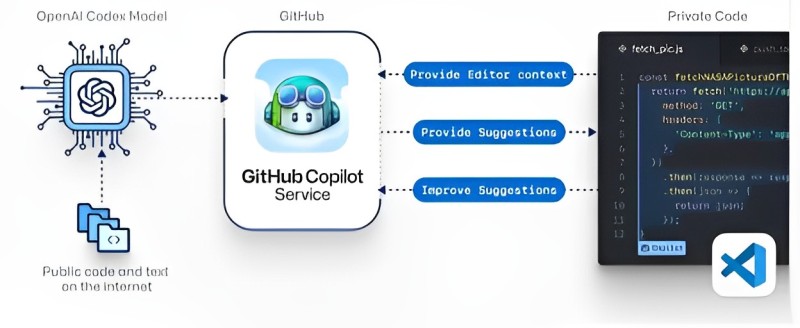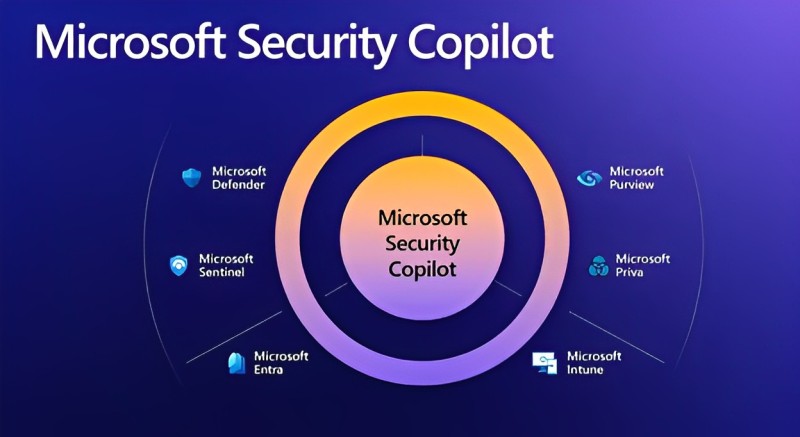
AI Assistant within Azure DevOps
Developers face unrelenting demands to deliver innovation faster despite skills shortages.
Github’s Copilot artificial intelligence programming assistant aims to boost individual and team productivity by suggesting context-aware code completions drawing on public code dataset training.
Early access previews suggest Copilot can alleviate grunt work, accelerate new project momentum, and enhance code quality through peer reviews.
But fully realizing Copilot’s potential requires thoughtfully integrating it into modern software delivery lifecycles enabled by DevOps automation platforms like Azure.
Let us explore key opportunities to harness Copilot within end-to-end developer workflows – from backlog management to continuous integration and monitoring. Partnering with a Java development company can further optimize these workflows, leveraging Copilot’s capabilities alongside Java expertise to streamline development processes and maximize software quality and efficiency.
Which AI is GitHub Copilot using?
Democratizing Access to Copilot

ICopilot provides tremendous potential to augment individual developers and amplify team productivity.
However, its current limitations as a paid individual preview restrict broader enterprise adoption.
To fully harness Copilot’s strengths for an engineering organization demands considering more flexible access models.
Technology leaders should evaluate several key elements to scale up Copilot-assisted development in a way that balances cost, security, and productivity enhancement across projects.
- You may want to engage Azure DevOps Implementation Services to integrate Copilot directly into developer IDEs with centralized provisioning.
- Group assignments and shared budgets can amortize costs while still personalizing Copilot interactions per developer.
- Built-in security controls block leaks of proprietary code or artifacts into public training data.
Streamlining Developer Onboarding

Onboarding efficiency is crucial for accelerating new developers’ initial contributions to a codebase.
Copilot has exciting potential to speed up initial orientation by providing intelligent suggestions adapted to team conventions versus strict top-down rules.
Technology leads should creatively explore ways to incorporate Copilot into developer onboarding flows in the following ways:
- New developers can instantly tap into Copilot suggestions accelerating initial productivity.
- Copilot rapidly absorbs context from surrounding code, documentation, and tickets.
- It proactively offers common style and pattern implementations fitting the specific codebase.
This allows novices to learn conventions by example rather than strict rules.
- Copilot progressively personalizes recommendations based on individual developer preferences.
Boosting Velocity across Project Stages
Software delivery velocity is essential for responding quickly to changing business or customer needs.
Copilot offers promising capabilities to assist developers throughout the full application lifecycle – from initial prototypes through production bug fixes.
Engineering managers should assess potential Copilot value-ads across these core project stages:
- Copilot speeds prototype development by generating common boilerplate code.
- It provides dynamic scaffolding of classes, interfaces, and configurations.
- Code suggestions align with project architecture and patterns.
- In production, Copilot helps insert forgotten edge cases or handles frequent syntax needs.
- Integrations with team project management clarify business requirements and acceptance criteria.
Enhancing Code Quality
Delivering stable and secure code requires upholding quality standards through reviews and testing.
Copilot provides unique opportunities to boost quality by incorporating billions of data points on strong programming approaches.
Teams should explore techniques to validate and enhance Copilot-generated code such as:
- Copilot cites any open-source code it suggests to promote licensing compliance.
- Its predictions draw on billions of data points gauging strong programming practices.
- Code reviews validate that Copilot-generated code meets quality standards.
- Over time, human feedback further tailors Copilot recommendations improving relevancy.
- Copilot suggestions stimulate peer discussions about ideal patterns.
Optimizing Task Estimations
Accurate estimates empower agile teams to meet predictable delivery cadences for stakeholders. Copilot provides data to quantify typical boosts in developer productivity for factoring into estimates.
To leverage Copilot data for estimation, teams should:
- Data on historical Copilot adoption rates by project type informs task estimates.
- Tracking suggestion acceptance percentages provides metrics on typical boosts in developer velocity.
- Teams quantify how much Copilot typically reduces grunt work like unit test writing or refactoring.
- Time savings get reallocated to stretch goals like performance testing or UX polish rather than cuts.
- Shared metrics illustrate opportunities to further incorporate Copilot into team workflows.
Monitoring Usage and Productivity
Maximizing Copilot’s return requires data quantifying individual and team usage trends.
Metrics identifying adoption rates and patterns inform appropriate nudging while revealing gaps needing performance tuning.
Analytics leaders should explore monitoring initiatives like:
- Dashboards track Copilot suggestion frequency and acceptance rates per developer.
- Data determines optimal nudge rates balancing assistance vs distraction.
- Integrations with work tracking quantify time savings on common tasks.
- Teams assess gaps where Copilot should improve via personalized fine-tuning.
- Anomaly detection identifies usage drops warranting troubleshooting.
- Sharing metrics fosters healthy usage competition between developers.
Continuously Improving Suggestions
The true power of Copilot emerges over time as developer feedback personalizes predictions specifically fitted to team needs versus generic public code training data.
Ongoing fine-tuning unlocks Copilot’s full potential through:
- Developer feedback trains enterprise Copilot models to improve version predictions.
- Local contextual adaptations prevent inappropriate public code creep.
- Teams cleanse undesirable suggestions through downvotes plus source code reviews.
- Ongoing fine-tuning ensures high relevance for specialized projects.
- New team members can rapidly personalize Copilot’s behaviors by example.
- Tight iteration cycles will elevate Copilot’s capabilities over time via hands-on use.
Securing Copilot Interactions

Any AI assistant requires thoughtful governance to avoid unintentional data leakage or misuse while balancing productivity. Copilot’s integration warrants applying security best practices.
Engineering leaders should implement policies including:
- Audit logs monitor Copilot activity to understand data touch points.
- Code reviews assess any anonymized snippet contributions back to GitHub.
- Policy controls block Copilot usage when dealing with sensitive code or artifacts.
- Data Loss Prevention (DLP) tools identify and mask any private data preemptively.
- Multi-factor authentication protects developer accounts accessing Copilot.
- Proactive governance avoids leakage of proprietary details into public training data.
Automating Repetitive Coding Tasks
Copilot has the potential to eliminate much of the repetitive, mundane work developers face daily.
This frees up time and mental focus for higher-value creative challenges. Engineering leaders should assess common coding tasks that Copilot could automate:
- Automatically generating getters/setters for classes based on properties.
- Inserting boilerplate code for imports, logging, error handling, etc.
- Suggest naming conventions for methods, variables, and classes per coding standards.
- Providing auto-complete for common syntax structures and patterns.
- Generating comprehensive unit test stubs for new functions.
- Recommending fixes for issues like resolving merge conflicts and deprecated syntax.
- Identifying redundant logic to consolidate through refactoring.
- Expanding outlines and stubs into complete component implementations.
- Handling frequent data transformation/mapping needs between systems.
Thoughtfully applying Copilot to automate coding drudgery enables developers to focus efforts further up the value chain on differentiating user experiences.
Maximizing Knowledge Sharing
Copilot suggestions reflect aggregated patterns from billions of data points.
This community knowledge can powerfully enhance teams through shared best practices beyond individual experience.
- Create internal knowledge bases of approved Copilot-generated code for institutional reuse.
- Guide junior developers through mentoring workflows based on real examples.
- Discuss commonly provided Copilot recommendations at architecture reviews to spread learnings.
- Build libraries of optimized components for reapplication rather than reinventing.
- Share templates of high-quality code addressing complex needs like security, accessibility, and globalization.
- Continuously enhance governance based on emerging risks revealed through Copilot code review.
- Populate customized sets of organizational design patterns for Copilot to prioritize.
Judiciously leveraging the crowd-sourced wisdom woven into Copilot recommendations sustains gains through collaboration rather than just individual gains.
Engineering a Consistent Developer Experience
Complex workflows diminish Copilot’s seamless integration. Containers, configuration control, and accessibility settings enable frictionless usage across projects.
You may want to leverage Azure DevOps Implementation Services to:
- Unified Copilot configurations follow technologists across projects.
- Containerized environments preserve personalized settings between applications.
- Centralized controls apply policies for security, resource allocation, and usage.
- Contextual awareness remains intact as developers switch tasks while Copilot adjusts appropriately to the evolving codebase.
- Monitoring ensures Copilot performs reliably across on-prem, cloud, and hybrid environments.
The potential for tools like Copilot to augment human ingenuity is tremendous as azure AI multi-service capabilities advance.
However, rather than installing assistants randomly, it will be critical to carefully integrate them into current team operations.
With careful orchestration, Copilot offers another promising mechanism for empowering developers and unlocking productivity amidst soaring technology demands.
How are you looking to incorporate AI-powered developer assistants like Copilot into your DevOps toolchain?
What benefits or concerns do you anticipate? We would love to hear your experiences and thoughts on navigating this emerging frontier.



